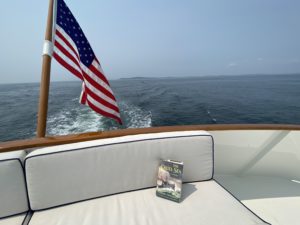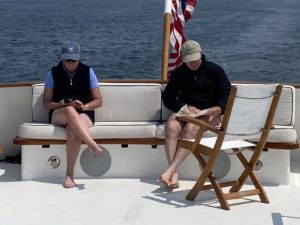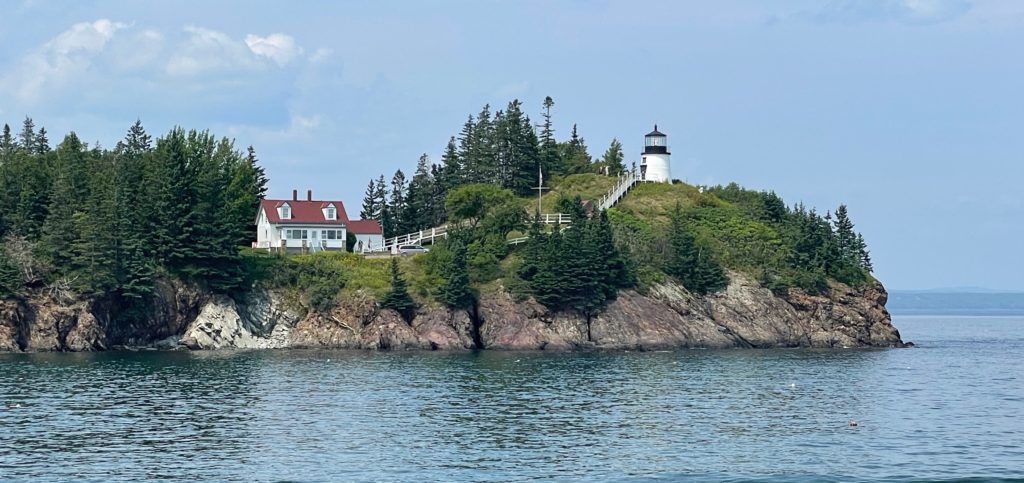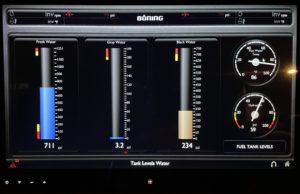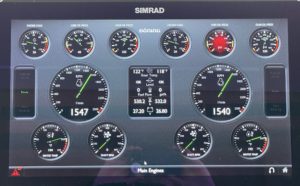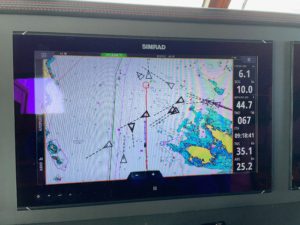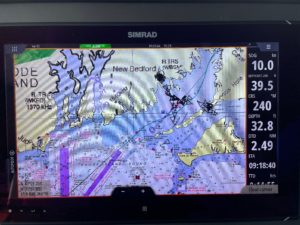In which Sid and Doris see the legendary puffin.
How many people does it take to get in a Nereus-sized fender? Only one, if they are a small but extremely determined Betka. Or two large muscular men.
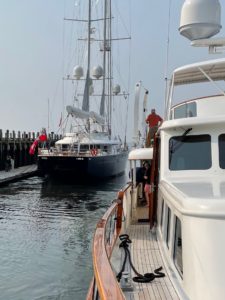
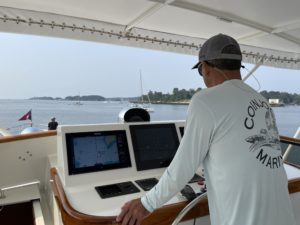 Sid and Doris find that leaving the dock is often a touch fraught but Wes was cool. Nereus went sideways using the bow thruster, rudder and the two props. And then went (outwardly) calmly backwards past Tamsen (“just leave that fender out for a couple more minutes”) before turning around and leaving the harbour en route north to Rockland for the racing out of Camden.
Sid and Doris find that leaving the dock is often a touch fraught but Wes was cool. Nereus went sideways using the bow thruster, rudder and the two props. And then went (outwardly) calmly backwards past Tamsen (“just leave that fender out for a couple more minutes”) before turning around and leaving the harbour en route north to Rockland for the racing out of Camden.
The Maine coast is a martyr to lobster fishing with pots everywhere. Maine is famous for lobster. Thousands of cages and lines clog the sea bottom. Sid reads that Maine’s lobster fishing industry makes $400m per year and we can see it defines the coast and tourist industry. (For context, Sid’s guess is that Maine hairdressing businesses make about $1,000m.) With the water getting warmer there are fewer and fewer lobster so the State of Maine is promoting aquaculture which is becoming more environmentally friendly as big bags collect all the salmon poop and lice. Certainly fish farms will be less of a hazard to shipping, whales and dolphins all of which carry the scars from collisions with the lines from lobster cage to their marker buoys.
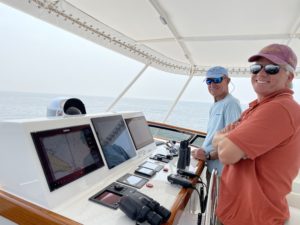 The morning drifts happily by and we go up to Nereus’ fly bridge, about 15′ above the water and giving much more view than we would get from our usual yacht cockpits. We enjoy looking at the other marine traffic on our way to Muscongas Bay and Eastern Egg Rock with its justly famous puffin and tern colonies. This was the world’s first restored sea bird colony; the project starting in 1973. The first job was to reduce the gull threat and then to introduce new puffins from Newfoundland. There are now about 200 nesting pairs of puffins and 1,000 pairs of tern.
The morning drifts happily by and we go up to Nereus’ fly bridge, about 15′ above the water and giving much more view than we would get from our usual yacht cockpits. We enjoy looking at the other marine traffic on our way to Muscongas Bay and Eastern Egg Rock with its justly famous puffin and tern colonies. This was the world’s first restored sea bird colony; the project starting in 1973. The first job was to reduce the gull threat and then to introduce new puffins from Newfoundland. There are now about 200 nesting pairs of puffins and 1,000 pairs of tern.
Sid and Doris are great fans of the orange beaked awks but you may remember we have not had much luck finding them. They live at sea apart from during their breeding season, going back once the young are seaworthy. While their beaks are no longer peak season orange we are delighted to see plenty of them diving and fishing just off the island. Joe says he is very relieved, having worried that he had over-promised on the matter of puffins.
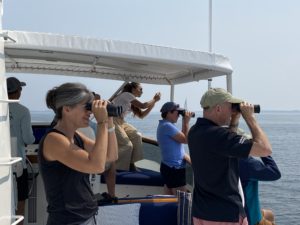
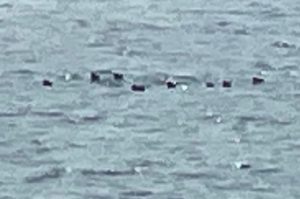
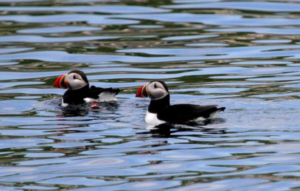 [Nereus has many pairs of excellent binoculars on board – Sid and Doris have promised themselves to buy a decent Steiner or Canon pair after this trip – so we saw the puffins in deatail but even the iPhone’s camera is not up to the task of capturing it. So many thanks to Mr JD Wilson for his photograph of Maine puffins – D.]
[Nereus has many pairs of excellent binoculars on board – Sid and Doris have promised themselves to buy a decent Steiner or Canon pair after this trip – so we saw the puffins in deatail but even the iPhone’s camera is not up to the task of capturing it. So many thanks to Mr JD Wilson for his photograph of Maine puffins – D.]
The afternoon passes in a blur of busyness.
We spot dolphins and seals and the other big excitement is a Mola Mola or Ocean Sunfish which is a heavy, bony fish. We first saw a fin and then a surprising amount of the fish could be seen, though we have no picture of our own.
We pass the very scenic Owls Head lighthouse and go round into the Rockland end of Camden bay.
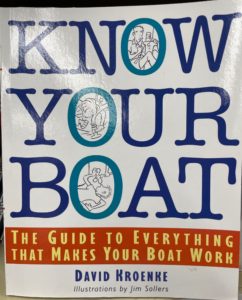 Rockland is a well sheltered harbour and home to the local coastguard boats. The docking is no fuss Norris and we are ready to put the passarelle together again. Sid marvels at the powered rollers that drive the shore power cables out of their drums and along to the outlets on the pontoon. Running Nereus is not a one person job – it has ship-style systems rather than the boat-scale ones that Sid and Doris are used to. For a metaphor, think of running a town rather than a caravan. Fortunately the local chandler’s has a helpful book which we think will sort out all of Captain Wes’s challenges.
Rockland is a well sheltered harbour and home to the local coastguard boats. The docking is no fuss Norris and we are ready to put the passarelle together again. Sid marvels at the powered rollers that drive the shore power cables out of their drums and along to the outlets on the pontoon. Running Nereus is not a one person job – it has ship-style systems rather than the boat-scale ones that Sid and Doris are used to. For a metaphor, think of running a town rather than a caravan. Fortunately the local chandler’s has a helpful book which we think will sort out all of Captain Wes’s challenges.
Just by us on the dock is a 45′ painted aluminium boat out of Dartmouth, Devon. It is a French Garcia (very like an Ovni with retracting keel). Bill and Sid chat up the owner and ask after his voyages. The owner thinks it is a full time job to maintain. He is parked next to Nereus.
